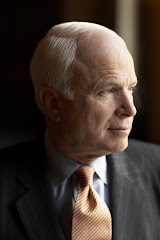CTW #4
Military hero, senator and Republican favorite for the 2008 US elections, McCain has Custer's saber at home
JOHN McCAIN AND THE BOYGENERAL

| 1. The room: Called "the Indian room." Distinctively Southwestern. An addition designed by Cindy McCain. 19 by 29 feet; 12-foot pine ceiling. Presided over by a 6-foot cigar-store Indian. 2. Swords: The one above the bookcase once was owned by Gen. George Custer. The glass-encased one was presented to McCain by the Valley Forge (Pa.) Military Academy for distinguished service. 3. Dolls: A dozen kachina dolls crafted by Hopi artisans are all gifts. "There are supposed to be spirits in these dolls," McCain says. "Sen. [Barry] Goldwater had hundreds." | 4. Plaques: Reminders of McCain's military career. Inscription on one: "4th Allied POW Wing/ Return with Honor." 5. The furniture: Cushioned, reed-wood-framed couches and chairs. Glass tables, one with a book of photos taken by Goldwater. 6. Rugs: Collection of antique throw rugs from a Navajo reservation blanket the pine floors. Not pictured: Texas steer horns. World War II-era Coca-Cola machine. Turn-of-the-20th-century player piano. Branding iron (never used on animals) by the fireplace. NFL helmet signed by the entire Arizona Cardinals team. |
 John McCain is a U.S. Senator from Arizona and a Republican candidate for president in 2008.
John McCain is a U.S. Senator from Arizona and a Republican candidate for president in 2008.
John Sidney McCain was born on August 29, 1936, in the Panama Canal Zone. Born into a family with a distinguished reputation in the U.S. Navy, both his father and grandfather were admirals and his father rose to command all the U.S. naval forces in the Pacific, McCain spent his childhood and adolescent years moving between naval bases in America and abroad.
He graduated from the Naval Academy at Annapolis in 1958 and trained as a Navy pilot. With the outbreak of the Vietnam War, McCain volunteered for combat duty and began flying carrier-based attack planes on low-altitude bombing runs against the North Vietnamese.
On October 26, 1967, during his 23rd air mission, McCain's plane was shot down over the North Vietnamese capital of Hanoi. His captors soon learned he was the son of a high-ranking officer in the U.S. Navy and repeatedly offered him early release, but McCain refused, not wanting to violate the military code of conduct and knowing that the North Vietnamese would use his release as a powerful piece of propaganda.
He eventually spent five and a half years in various prison camps, three and a half of those in solitary confinement, and was repeatedly beaten and tortured before he was finally released, along with other American POWs, in March 1973, two months after the Vietnam cease fire went into effect.
Though McCain had lost most of his physical strength and flexibility, he was determined to continue serving as a naval aviator. After a painful nine months of rehabilitation, he returned to flying duty, but it soon became clear that his injuries had permanently impaired his ability to advance in the Navy.
